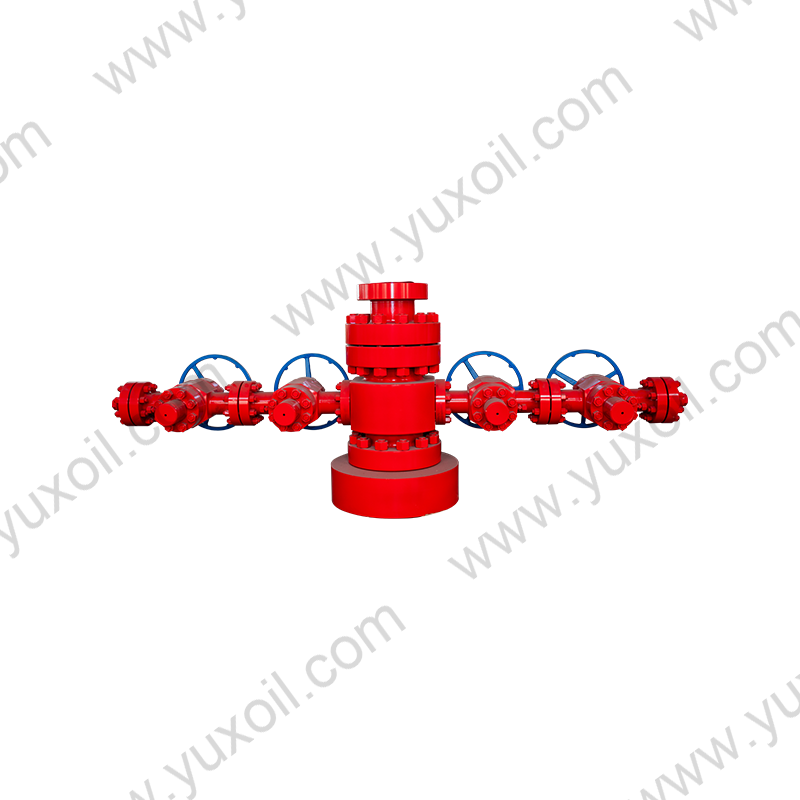-

+86-13961903990
 2025.08.04
2025.08.04
 Industry News
Industry News
Introduction
Oil and gas wellhead equipment is an important hub connecting underground wellbore and surface production system. It is responsible for withstanding high pressure, high temperature and corrosive fluid from underground, while ensuring safe control and diversion operations. In wellhead equipment, Casing Spool, Tees and Crosses play a key role. They are not only the components of wellhead equipment, but also the core to ensure the safety and efficiency of operations.
1. Function and structure of Casing Spool
Function of Casing Spool
Casing Spool is an important pressure-bearing component in the wellhead device. It is usually installed at the bottom of the wellhead, between the casing hanger (Casing Hanger) and the blowout preventer (BOP), and has the following functions:
Carrying the weight of the casing: During the drilling process, each layer of casing is supported by the Casing Spool to bear its weight and the weight of the auxiliary equipment.
Achieving pressure sealing: There are multiple casing annuli (Casing Annulus) at the wellhead. The Casing Spool achieves independent sealing of the casing annuli at each level by installing a hanger and a sealing device to prevent oil and gas crossflow.
Providing an interface for annular operations: The side outlet of the Casing Spool can be connected to a drain valve and a pressure monitoring device, which is convenient for annular weighting, drainage or monitoring operations.
Structural features
Main body: Forged with high-strength alloy steel (common material AISI 4130), it has high pressure resistance and impact resistance. The working pressure is usually between 2,000 PSI and 15,000 PSI.
Hanging device: Casing Hanger is installed inside to fix the lowered casing string.
Sealing system: Common sealing forms include metal seals, rubber seals or combined seals to ensure the high-pressure sealing performance of the annulus.
Side outlet: Generally, two or four side outlets are configured for installing valves, pressure gauges, and drainage devices. The interface standard usually complies with the API 6A flange connection specification.
2. Function and structure of Tees and Crosses
Function overview
Tees and Crosses are important components of wellhead and manifold systems. They are often installed in choke manifolds, fracturing pipelines or test devices. The main functions include:
Fluid diversion and confluence: guide the wellhead produced fluid to different directions such as choke valves, fracturing pumps, test equipment, etc., or merge multiple fluids and transport them to subsequent processing systems.
Pressure monitoring and control: Install a pressure gauge or sensor through the side port to achieve real-time pressure monitoring and ensure operational safety.
Connect multiple operating equipment: Under complex working conditions such as fracturing, acidizing, and well repair, Tees and Crosses can be flexibly configured to meet the needs of multi-way parallel operations.
Differences between Tees and Crosses
Tees (tees): have one inlet and two outlets, in a "T" shape, suitable for single-branch fluid diversion or injection.
Crosses (four-way): have one inlet and three outlets, in a "cross" shape, suitable for multi-way parallel working conditions, such as connecting throttling, fracturing, and back pressure pipelines at the same time.
Structural and design features
Manufacturing process: high-strength forged steel is used, heat-treated to improve wear resistance and impact resistance, and the surface is usually treated with anti-corrosion coating.
Connection method: Common connection methods include API flange connection, threaded connection or quick clamp connection, which is convenient for rapid installation and disassembly on site.
Inner cavity design: The internal flow channel is optimized to reduce flow resistance and erosion and increase service life. For fracturing conditions, the inner wall can be sprayed with wear-resistant materials to resist sand erosion.
Pressure level: Common pressure levels are 5,000 PSI, 10,000 PSI and 15,000 PSI, which can meet different wellhead pressure requirements.

3. The synergy of the three in the wellhead system
Casing Spool, Tees and Crosses do not operate independently, but work together in wellhead operations:
Casing Spool provides basic bearing and sealing: it constitutes the "skeleton" of the wellhead structure, supports the upper equipment and isolates different annular pressures.
Tees and Crosses complete fluid allocation and pressure control: through their multi-outlet design, they can achieve wellhead fluid diversion, pressure detection and external equipment access.
Safety and flexibility of the overall system: This modular design makes the wellhead highly adaptable to meet different operational requirements such as drilling, fracturing, well repair, and testing.
4. Standards, materials and selection recommendations
Standard specifications
API 6A: "Wellhead Equipment and Christmas Trees" is the main international standard for the design, manufacture and testing of wellhead equipment.
ISO 10423: An international standard equivalent to API 6A, applicable to the global oil and gas industry.
NACE MR0175: Material requirements for H₂S conditions to prevent hydrogen sulfide stress cracking.
Material selection
Normal conditions: AISI 4130 forged steel, with high strength and good toughness.
Sour conditions: Use CRA (corrosion resistant alloy) or stainless steel, such as 410SS, 17-4PH, to improve corrosion resistance.
High pressure and high temperature (HPHT) conditions: Special alloy steel or nickel-based alloy is required to ensure long-term stability.
Selection points
Select the appropriate pressure level (2,000 PSI~15,000 PSI) according to the wellhead pressure.
Select the material according to the working conditions (corrosive media, temperature, abrasiveness).
Consider interface standards and wellhead system compatibility (API 6A flange size).
5. Future trends
High-pressure and high-temperature adaptability: With the development of unconventional oil and gas, wellhead equipment must have a pressure-bearing capacity of more than 20,000 PSI.
Improved corrosion and wear resistance: Use advanced materials and coating processes to increase equipment life.
Intelligent development: Integrated pressure monitoring sensors to achieve real-time data collection and remote control at the wellhead, improving safety and automation levels.